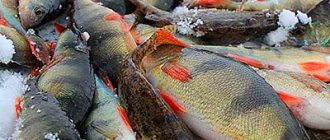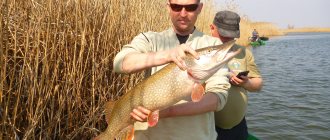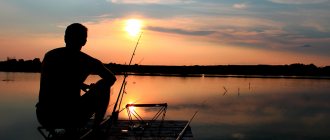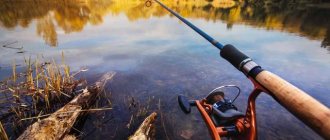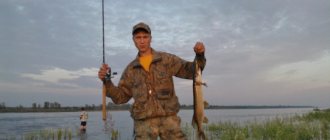Grayling: description and behavioral characteristics
Grayling is a predator with a long, slender body and a rear adipose fin characteristic of the salmon family. It is distinguished from salmonids by its large, sail-like upper fin, which has more than 20 rays.
The scales are small, very dense and securely attached to the skin. The size depends on the habitat and food supply. The fish has an upper mouth and small teeth in the form of bristles. This is a very cautious and timid fish. Found in clean, cold water with strong currents. Therefore, not all fishermen can boast of catching this tasty and rather rare fish, since it lives only in northern rivers.
This is a fish that does not leave a certain area of the reservoir throughout its life, and if it migrates, it is within 40 kilometers.
Lures
The Krasnoyarsk hydroelectric power station, built in 1972, changed the food preferences of grayling. This is especially true for fish living in the lower reaches. The riverbed in this area was filled with freshwater shrimp (Angara gammarus), which became a favorite delicacy of grayling. During the feeding season, fish will not refuse bottom caddisflies, stoneflies or mayflies, but gammarus has captured the title of the most catchable bait.
The famous Siberian flies are popular among artificial baits. Krasnoyarsk fishermen consider wet flies with a bright head or ovipositor to be the best. The preferred materials are rooster feathers, animal hair and green lurex. A correctly tied fly completely imitates insects living in a pond.
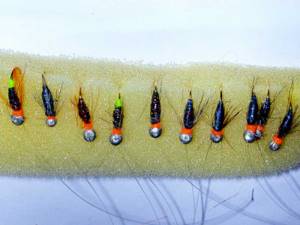
Grayling's attention is attracted by bright flies clearly visible in the water.
Purple cambrics equipped with small beads are also in use. It has been noticed that grayling reacts especially actively to this color.
Grayling fishing in Krasnoyarsk will not disappoint amateurs and professionals. If you don’t want to master local methods, you can use the usual float rod with bait in the form of maggots, larvae or a worm. Visiting fishermen successfully use a spinning rod with an inertial or multiplier reel, a rigid action and a cast of 70–80 g. Grayling fishing will be successful if you stock up on a large number of different baits: the fish is capricious and spoiled by an abundance of food. It is difficult to predict in advance which bait will seduce the Siberian beauty at a particular time of day.
Main types of grayling
- Siberian. He has a very large mouth, compared to the European one, the upper jaw reaches the eye, the teeth are larger. The color is almost the same as that of the European species. In large rivers, it is found with a silvery and bright color. In streams there are specimens that are much darker, with a purple tint.
- European. Long slender body. The scales on the belly are smaller than on the sides. The fin on the back is very high, has up to 24 rays, and contains bright spots. There are small fins on the abdomen and chest. Small lower mouth, teeth are almost invisible. Gray back with green tint and dark spots. Basically, the weight does not exceed 1.5 kilograms, and the length is no more than 50 cm.
- Mongolian. This species differs from others in its long head, large mouth, but most importantly, its teeth are larger than those of other species of the grayling family. The belly is light, the back and side have a grayish tint. The dorsal fin is also gray, with rounded faded red spots. Tail and ventral fin orange with lilac
Grayling habitats
This species can live exclusively in fresh and clean water. They like mountain rivers with strong currents, cold and clean water. For parking they prefer a rocky bottom. This fish is found in the Far East, Siberia, as well as in the Baltic and White Sea basins, and in other northern parts.
Grayling can also live in spring lakes, where the favorite place is a rocky bottom. In the Baikal basin, it stands on shallows, rifts, and in places with fast currents. It moves to deep places in winter.
If the river is large, then he will not stand near the shore, he will try to move as far away as possible. He always tries to find shelter for himself: stones, fallen trees, rifts are his favorite places.
In this case, next to the shelter there should be a window without ripples, he watches this place, and waits for some insect to fall or swim by. In the morning and in the evening, he is less careful and can go hunting on the shore.
Grayling fishing calendar by season
- January. At this time, the grayling stands in the depths and bites reluctantly.
- February. Here everything depends on weather conditions, so you can’t predict what the bite will be.
- March. This period is transitional. The bite is weak at the beginning of the month, but from the 15th there will be a good winter catch.
- April. Fish that are not yet very active can be caught by wire in rivers with strong currents; a worm is suitable as bait. In the second half of the month the bite will improve slightly.
- May . At the beginning of the month, everything depends on the convergence of ice on reservoirs. Grayling can be caught using worms, bark beetle larvae, maggots, and bottom tackle. In the second half, it can be caught using artificial flies that imitate natural flies.
- June. The bite is getting better and better. You can catch with artificial aerial insects, as well as with a worm.
- July. At this time there is a peak in fish activity, due to the fact that many insects appear, which grayling likes to hunt for.
- August. At this time, activity continues, a good time for fans of spinning fishing.
- September. Grayling descends onto the pits. You can catch it in the wiring with a worm.
- October. It is caught preferably in pits using various insects, using a fishing rod or bottom tackle.
- November. Fish activity deteriorates significantly. It is caught near deep-sea holes.
- December. With the onset of cold weather, it becomes practically inactive and descends to the deep-water sections of the river.
Krasnoyarsk "hangarka"
Another effective tackle for catching grayling on the Yenisei and its tributaries is the riding gear. Fishermen of the Krasnoyarsk Territory call it “hangarka”. It is similar in structure to the “boom”, but the float consists of two parts. The top one is made of floating material: wood, cork, foam. The lower one is loaded with lead.
For hangar fishing, a spinning rod 2.7–3 meters long, equipped with a spinning reel, is used. The tackle is thrown from the shore directly into the main stream of fast current (threshold, riffle), after which it is smoothly released in an arc. The flies or other baits remain on the surface. The line is slowly reeled in, constantly held in tension, until the tackle is carried to the shore.
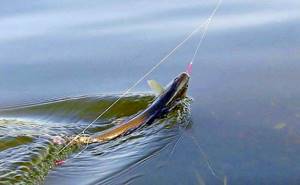
In Krasnoyarsk, grayling is caught using various types of donks
You can catch grayling in the Krasnoyarsk Territory not only using local methods. A regular float rod with bait in the form of maggots, larvae or a worm is quite suitable. Visiting fishermen successfully use a spinning rod with an inertial or multiplier reel, a rigid action and a cast of 70–80 g.
Ways to catch grayling
On a float rod
You can fish for this fish after the ice melts on the rapids and meadows. The rod is chosen up to 5 meters long. Main line 0.15–0.30 mm. We install a small float 6–8 cm, preferably transparent. We fix the weight closer to the float, it is necessary to balance it so that there is the best sensitivity.
Then we attach a leash of 0.08–0.11 mm, and a length of 25–35 cm. The hook is suitable for numbers 5–6, but you should not choose thin hooks, it has delicate lips, and when hooking, it can tear them. From a boat or from the shore, the bait is launched into the current, with rapids and caught in the retrieve.
In winter, it is better to fish for worms, caddis flies and maggots. In summer, the favorite bait will be the grasshopper, but it will not disdain flies or other insects.
2-3 worms or a sandwich of different insects are placed on the hook. Thanks to the strong current, the bait remains suspended above the stones.
This creates a natural insect behavior that will attract the desired fish. Grayling loves moving bait, so for successful bait fishing you need to play all the time.
When retrieving, you should play with the fish, it should become interested in the bait, and if this is successful, a bite will undoubtedly follow, and the fisherman will never be left empty-handed. Many people rub the leash with fat and wax for greater buoyancy.
For spinning
For fishing you will need a lite or ultra lite spinning rod with a weight of up to 7 grams. It is best to take a braided line 0.10–0.15 cm. This will facilitate good and long-distance casting of light tackle and ensure good sensitivity of the tackle. An inertia-free reel is also suitable, on which the friction should be adjusted to avoid breaks. For a good bite, it is best to do a slow retrieve.
Suitable baits include micro-jigs, small wobblers and spinners. When fishing with a small spoon, go downstream and cast it to the opposite bank. Having made a long cast, there is no need to rush, move the bait slowly, and the chance of catching a fish will increase, the fisherman will never be left without a catch.
When casting, you need to try to put the bait right under your nose so that the bait splashes on the water, the fish will instinctively swallow it and be hooked. It is worth remembering that any sudden changes in the weather greatly affect the intensity of the bite, so with strong changes, the bite can significantly worsen.
Fly fishing
The size and weight of the fly is very small, so for fly fishing a lighter class rod is used. We select the length of the rod according to the width of the reservoir; the wider the river, the longer the rod should be for longer casting. Floating line up to grade 7-8 should be used for dry flies.
If you fish with a wet fly, you can install a floating line with a sinking end. You can use a line less than 0.2 mm on the leash. If you use a 2–2.5 hook, then you should not use a leash thicker than 0.1–0.2 mm.
Thick leashes can be used if you are going to hunt for large specimens, and in places with inconvenient fishing.
In the spring it stands at the bottom, and in this case wet flies pay off. In the summer it comes to the surface and dry flies work better.
To the boat
For many, this tackle is very simple, it consists of a boat, a fishing line with a fly and any device for winding the fishing line (often using a spinning rod).
In order to launch the bait correctly, place the spinning rod close to the water. Next, we carefully lower our vessel into the water and set it drifting, unwinding the fishing line. If the boat has reached the fishing spot, then we tighten the main line so that the flies lightly touch the water. After which we slowly walk along the shore while steering the boat.
Many people use catamaran boats - this allows it to not capsize and stand stably on the water. To prevent the leashes from getting tangled, they are threaded through special devices and secured to the fishing line with knots. It is much better to fish in places with an open bank so that you can easily move behind the floating tackle. You should come to the pond early in the morning, and when the sun is at its zenith, the shadow from the fishing line will fall, which can frighten the fish.
How to catch grayling
Tackle for catching grayling should be distinguished by the lightness of the forms and components of the equipment, as well as the subtlety of installation.
Important! Hunting for this representative of salmon fish is quite dynamic and requires constant monitoring of baits, and for fly fishing, special training in the skill of casting a fly.
When completing tackle for spinning, float and fly fishing, select the lightest graphite rod, the use of which will not tire the angler with frequent casts. For cords, nylon fishing lines are used, which perfectly dampen the jerks of caught fish, and hooks are used with an elongated shank, size 10–12. Wade fishing is always more successful than shore hunting, and the presence of waders for an angler will help to significantly increase the number of catches. The angler will learn about the features of using various fishing methods and baits depending on the season of the year from further material in the article, with a focus on the main nuances of the technology.
in spring
For still muddy spring waters, the use of float gear is justified, with the help of which baits of animal origin are placed in the middle water levels above the places where the fish are supposed to stay.

Important! The speed of the wiring is comparable to the speed of the current without delays or stops. The nature of the presentation of an insect, thin dung worm, bloodworm or maggot does not cause suspicion in the fish and if the presentation trajectory is successful, it will definitely take the bait.
Fishing using bombards and wobblers with low-frequency, not sweeping action is effective. The float should keep the bait in the middle water horizon, and the wiring itself is performed at an average pace of winding the cord without pauses or freezes.
In summer
In the summer, fly fishing becomes the priority method of catching predators. Fishing is done from the surface using a dry fly as bait. Fly fishing for grayling on riffles and rapids brings more bites than on the borders of fast and standing water. After casting, the fly is allowed to swim along the surface with slight twitches and pauses. The slightest touch of the bait by the fish is accompanied by an energetic hook. Long distances are fished using a floating bombard, relocating the predator's supposed stopping place. Bringing the fly to a promising point, they make holds and pauses, at the moment of which the bite occurs.
in autumn
In the fall, fly fishing continues, but the best fly will be in the wet version. The predator stops taking bait from the surface and begins to hunt in the water column. Spinning fishing using small spinners and silicone can be superior to fly fishing in terms of catchability. Uniform movements, without touching the bottom, are carried out on rapids and on the trajectories of contact of the main current with the creeks. In the fall, it is justified to use a boat equipped with both artificial flies and hooks with bloodworm and maggot attachments.
in winter
After the pond freezes, fishing is carried out with winter fishing rods, light balalaikas, with the installation of jigs and replanting bloodworms on them. The bait is played in the water column, making low throws alternating them with a short pause. On currents, they use the ice fishing technique using float equipment, placing an artificial fly as bait, which is fed into the middle horizons of the water and lures a predator, playing with the force of the current. Fishing with winter baits placed along the stream using flies or small silicone as bait is no less productive.
The best lure models for grayling fishing
- Turntables. Aglia No. 00 Long No. 00 and from the manufacturer Mepps. These spinners have become the best, and have proven themselves to be excellent when catching medium-sized grayling 200–400 years old.
- Oscillators. In this case, it is worth preparing at least a dozen baits up to 45 mm of different shapes and colors. Which one to choose? It’s up to you to decide, it all depends on the place of fishing and the harmfulness of the fish.
- Wobblers. Anglers Republic BM-25SR, as well as BM-20SR. These small fish work great when fishing for grayling. It is worth noting that he prefers uniform wiring. It all depends on the fishing location: Aqua Bit wobblers work well in large currents; Yo-Zuri are wonderful wobblers with a dive of up to half a meter.
- On an underwater fly. Here you should select flies with different colors. An imitation wasp or bee may work on one body of water, but on another you may not catch anything with it. Therefore, you need to experiment and select a fly for a successful catch.
Tackle for grayling
To catch grayling, anglers use several types of gear. Each of them can bring an excellent catch at a specific time. The peculiarities of the reservoir should not be discounted. The most popular fishing rods are listed in the table.
| Choosing a fishing rod | open water | ice fishing |
| artificial bait | spinning, fly fishing, boat, “baler” | bulldozer, fishing rod for vertical trolling |
| natural baits | float rod, boat | jig fishing rod |
Techniques and tactics for catching grayling: tips and tricks
It is worth catching in much the same way as trout, but it has its own nuances. You need to be able to identify the places where it is standing, and in which places there are trout. If there are no trout in the river, then grayling will spread throughout the entire reservoir. Grayling may be tempted by the lure if it is held as close as possible to its stopping place. In fast currents you can fish without a float. When dropping the line from the reel, keep the line tensioned so as not to miss the bite.
Before you start unwinding the tackle, explore the reservoir, look for places where grayling can live. Try to present the fly directly under the fish's nose so that it can instantly take it.
Keep an eye on the weather, and if there are strong pressure changes, don’t expect to catch much, as the fish are very sensitive to weather changes. We hope that these tips helped you understand a little about fishing techniques.
Fishing on the bulldozer
An interesting way of catching grayling from under the ice in winter is using the bulldozer. The gear consists of a short fishing rod with a reel, monofilament with a diameter of 0.18-0.20 mm and a rig called a bulldozer. There are many options for equipment, but the principle of operation is the same. A cylindrical or cone-shaped lead weight has a transverse hole in the thin part at a distance of 2-3 mm from the edge. A piece of fishing line 0.16-0.18 mm is passed through the hole. On opposite sides of the lead weight, hooks with a long shank are attached to the fishing line. The ends of the fishing line are tied with a regular knot, after which the equipment is connected to the main fishing line. The hooks are decorated with red threads imitating bloodworms.
Playing with a bulldozer looks like this: The equipment is lowered to the bottom, the fishing line is fixed. With a wrist movement the bait is thrown, and after the bulldozer falls to the bottom there is a pause. At this moment the fish grabs the bait.
You can fish for grayling throughout the year. If you choose the right tackle for a specific body of water and time of year, you will have a chance to catch the most beautiful freshwater fish.
Rate the quality of the article. We want to be better for you:



